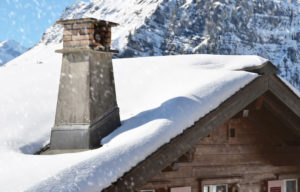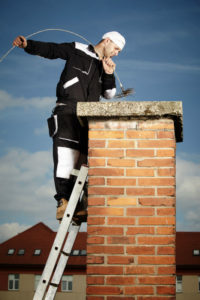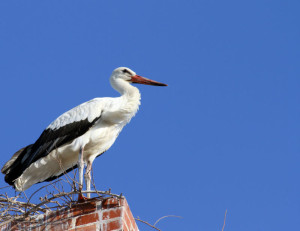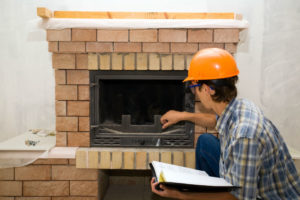Temperatures are dropping, leaves are changing and starting to fall, and many parts of the country have experienced the first snowfalls of the season. Fall is in full swing, and winter is just around the corner! With the change in the weather comes a change in how we use our heating appliances; fall and winter are known as burning seasons because of how often fireplaces, inserts, stoves, and other fuel-burning heating appliances are used.
 The Farmer’s Almanac has predicted that this winter will have big chills and strong storms; a fireplace can help create a warm, welcoming environment in your home no matter the weather. While chimney systems are built to burn fires year after year, they do need regular care, maintenance, and upkeep in order to operate safely and efficiently. The following tips and tricks can help ensure your fireplace and chimney are ready for the arrival of burning season.
The Farmer’s Almanac has predicted that this winter will have big chills and strong storms; a fireplace can help create a warm, welcoming environment in your home no matter the weather. While chimney systems are built to burn fires year after year, they do need regular care, maintenance, and upkeep in order to operate safely and efficiently. The following tips and tricks can help ensure your fireplace and chimney are ready for the arrival of burning season.
1. Schedule a sweeping and inspection as soon as possible
Burning season may be underway, but it’s still not too late to schedule a chimney sweeping and inspection! A chimney sweeping should be done at least once per year to remove soot, ash, and flammable creosote from the flue; likewise, inspections should be done annually to check for signs of damage or deterioration to the fireplace or chimney.
A chimney sweeping by a CSIA-certified chimney sweep can help ensure your fireplace is burning efficiently, extend the life of your chimney system, and significantly reduce the risk of a chimney fire. Fall and winter are the busiest seasons for chimney sweeps; because of this, it may take several weeks before your appointment can be scheduled. Want to beat the rush next year? Plan ahead and schedule your chimney maintenance in the offseason!
Have a gas fireplace? You still need to schedule a chimney inspection! Annual inspections of gas fireplaces are important to ensure that no components have shifted, no gas leaks are occurring, and the venting system is undamaged and has no blockages.
2. Choose the right firewood
Whether you have an insert, open-hearth fireplace, stove, or even an outdoor fire pit, the best fuel for your wood-burning fire is seasoned firewood. According to the CSIA, seasoned firewood is “wood that has a moisture content between 20-25%.” This low moisture content is achieved by cutting, stacking, and exposing wood to the elements for 6-12 months.
Seasoned wood produces less smoke, burns at a higher temperature, and produces less creosote than freshly cut or “green” firewood. Burning green wood should be avoided whenever possible; in addition to being difficult to ignite because of the high moisture content in the wood, green wood burns dirtier and produces excessive smoke – and creosote. Burning large amounts of greenwood often result in a mid-season call to the chimney sweep!
While it can be tempting to burn paper, packaging materials, or leftover scrap wood in the fireplace – particularly when unwrapping presents during the holidays – only firewood should be used in indoor fireplaces. Styrofoam, stained or painted wood, or even printed paper can release dangerous chemicals when burned; this can impact the air quality in your home or cause respiratory issues for friends and family. Likewise, burning plastics can melt onto fireplace components and cause long term damage to the chimney system.
3. Maintain smoke detectors and safety equipment
In the United States, three out of five fire-related deaths were in homes without working smoke alarms. Regularly testing and replacing smoke alarms, carbon monoxide detectors, and fire extinguishers are an important part of keeping friends and family safe when the fireplace is in use. Smoke and carbon monoxide detectors should be on every level of a home, as well as outside sleeping areas. Test alarms every six months and replace batteries as needed; replace safety equipment every 7-10 years to ensure they meet modern safety standards and technology.
A fire extinguisher should be purchased and placed in an easily-accessible area near the fireplace. Available at almost every big box or home improvement store, a working fire extinguisher can be used to prevent an unsafe situation from turning dangerous. A log rolling out of the fireplace, a fire burning out of control, or a stray ember landing on nearby furnishings are all situations where a fire extinguisher can help prevent devastating damage to a home.
4. Keep décor away from the fireplace
The stockings may have been hung by the chimney with care – but they need to be moved before the fireplace is used! During the holidays – and year-round – our mantles can hold décor such as garland, bunting, mementos, and more. Moving any hanging mantle décor out of the way before the fireplace is used can prevent stray sparks or embers from accidentally igniting a stocking; likewise, all carpets and other furnishings should be at least three feet away from the fireplace when in use.
Contact Jack Pixley Sweeps for your chimney needs this burning season
Following a few simple tips can keep your home safe and stress-free this burning season. Since 1977 staff has been providing the Minneapolis/Saint Paul area with quality, trustworthy fireplace and chimney services. For more information on fireplace safety or to schedule your next chimney sweeping or inspection, contact Jack Pixley Sweeps today!
While there are few truly wrong ways to light a fire, there are a number of fire starting techniques that can make lighting a fireplace fire easier and more efficient. Follow these five easy steps to help learn how to light your best ever fires in your fireplace this winter.
Step One
Have your fireplace swept and inspected each year. Whether you use your fireplace every day or only a few times per year, every chimney needs to be swept and inspected annually. This prevents buildup and blockages in the flue, as well as helps spot damage or deterioration before it causes major fireplace performance problems.
Step 2
Use the right firewood. The kind of firewood you use in your fires can have a major impact on fireplace performance. Firewood should be cut, stacked, and seasoned for at least a year to remove moisture content from the wood, helping it burn hotter and produce less smoke and creosote. Hardwoods such as ash, beech, cedar, maple, and oak burn hotter, more efficiently, and with less smoke; softwoods such as firs, pines, and spruces should be avoided in indoor fires. Likewise, woods from fruit trees such as cherry, apple, or plum are known for their pleasant aroma and can be used to create a pleasant smelling fire.
Step 3
Warm the flue. Before lighting even the kindling, make sure the damper is completely open. Opening the damper prevents smoke and gas from blowing back into your home. After opening the damper, there may be a rush of cold air for a few moments; if this downward draft of cold air continues for more than a few minutes, try warming the flue. Light rolled up newspaper and hold it directly below the damper. Doing this creates enough warm air to stop downdrafts without creating large amounts of smoke that can be blown back into your home.
Step 4
Start with kindling before adding wood. At the bottom of the grate, place rolled up lint, newspaper, or other fire starting aids between two large pieces of kindling wood. Create a second row of kindling lengthwise over the first stacked at a 90 degree angle; continue this until you have 3-4 rows of alternately-stacked kindling. Light the kindling from the newspaper at the bottom.
Step 5
Add logs after the kindling has ignited. Once the kindling is well-lit, begin adding firewood logs. Begin by placing 2 smaller, split logs onto the kindling; after 10 minutes, continue adding additional logs. Most smaller logs take between 5-15 minutes to burn; larger logs can burn for longer amounts of time, but also take longer to ignite. Try to add your next logs while the fire is still actively burning as adding wood on top of glowing charcoals or embers can be extremely difficult to ignite.
Contact Jack Pixley Sweeps
Following these steps to light your next fireplace fire can help ensure you have a fire that burns safer, more efficiently, longer, and with less smoke. For more information on the best way to start a fire in your fireplace, contact the chimney experts at Jack Pixley Sweeps today!
 While fall may not start until September 22, cooler temperatures are already starting to arrive. This year, make sure your fireplace is ready to go when the first cold snap hits by having your chimney swept now! It’s not too late to have your chimney swept for the year; annual maintenance is an important part of keeping your chimney burning efficiently, and now may be the perfect time to have it swept.
While fall may not start until September 22, cooler temperatures are already starting to arrive. This year, make sure your fireplace is ready to go when the first cold snap hits by having your chimney swept now! It’s not too late to have your chimney swept for the year; annual maintenance is an important part of keeping your chimney burning efficiently, and now may be the perfect time to have it swept.
The importance of annual chimney sweepings
Your fireplace needs attention more than just when you’re using it – or when it isn’t working properly. Regular preventative maintenance can help lengthen the lifespan of your chimney system while also keeping your fireplace burning safely and efficiently. One of the most important – and most well-known – annual maintenance items homeowners can have done is a chimney sweeping.
During the sweeping, the chimney sweep will use brushes, vacuums, and other tools to remove soot, ash, and creosote from the firebox and flue. The removal of creosote is one of the most important parts of the chimney sweeping; creosote is highly flammable, and the accidental ignition of creosote buildup in the chimney is the leading cause of chimney fires.
According to the Chimney Safety Institute of America, all chimneys – no matter how often they are used – should be swept at least once per year. This follows the National Fire Protection Association Standard 211 which says, “Chimneys, fireplaces, and vents shall be inspected at least once a year for soundness, freedom from deposits, and correct clearances. Cleaning, maintenance, and repairs shall be done if necessary.” Whether you use your fireplace a few times each season or are burning in it every day, maintenance needs to be done at least once per year. If you use your fireplace as a primary heating source in your home, it may need to be swept more often.
Don’t forget a chimney inspection!
In addition to your chimney sweeping, a chimney inspection can be another important part of annual maintenance.
“A chimney inspection is like an annual dental check-up,” says Ashley Eldridge, Director of Education for the CSIA. “It’s preventative maintenance that helps minimize potential hazards.”
During a chimney inspection, the chimney sweep will evaluate all accessible interior and exterior portions of the fireplace and chimney. Doing this can help identify any areas of damage or deterioration, often long before the fireplace has begun experiencing performance problem. This allows problem areas to be repaired sooner, saving you money on major repairs in the future.
Chimney inspections can also be used as a diagnostic tool. If you are experiencing a fireplace performance problem such as drafting issues, ongoing leaks, or repeated animal entry, a chimney inspection can help identify the root cause of the problem.
Whether you use your fireplace once per year or every day, a regular annual chimney sweeping is the best way to protect the longevity of your chimney system. To schedule your next chimney sweeping, contact Jack Pixley Sweeps today!
Scratching and clawing are sounds no homeowner wants to hear coming from their chimney. If you do, you may have an animal trapped inside.
The presence of an animal in the chimney is more than just a nuisance; animals often endanger themselves by getting stuck, can cause serious damage to your chimney components, and can expose your family to disease. Because of this, it is important to call a chimney professional at the first sign of animal entry.
How animals get in
Birds, raccoons, squirrels, and a number of other animals are known for trying to find their way into chimneys. Commonly, animals are able to get into the flues of uncapped chimneys or homes where the chimney cap has been damaged. Chimney caps that are ill-fitting, have shifted, or have damaged side screens can all leave gaps big enough for animals to get into. Raccoons have also been known to claw and scratch chimney caps until they break to gain entry.
Keeping animals out
The best way to keep out of your chimney is through regular chimney maintenance. An annual chimney inspection can help spot damage to the chimney cap and other chimney components. If repairs are needed, they can be quickly and easily completed – before animals get in.
I think I have an animal in my chimney – now what?
If you hear clawing, scratching, crying, or other animal noises coming from your chimney it is important to call a chimney professional as soon as possible. While animals may be able to find their way in, most are not able to get out on their own; when trapped and disoriented in the dark, enclosed space, wildlife rescue may be needed.
It is never recommended for homeowners to attempt to “smoke out” animals. First, opening the damper to start a fire can let whatever animal is in your chimney into your home; it is much easier to get a bird out of a chimney than it is a living room! Likewise, starting a fire with an animal in the chimney can be harmful to the animal as well as your home. The smoke, heat, and gasses from the fire often kill the animals long before they are able to escape up the chimney. If there are nesting materials in the chimney, sparks and embers from the fire can cause them to ignite and lead to chimney fires.
At Jack Pixley Sweeps, we provide professional animal removal services. We identify the area the animal is trapped in and remove four bricks; this creates an area large enough for the animal to escape on its own or be removed without causing significant damage to the chimney. By having a chimney company remove the animal, we are able to not only get the animals out, but repair the damage they have caused and keep them from coming back.
The presence of an animal in your chimney endangers the animals, causes chimney damage, and can expose your family to a variety of bacteria or diseases. At Jack Pixley Sweeps, we are experts at removing animals from your chimney – and keeping them from coming back. Contact us today for more information on wild animal removal.
After a long winter of use, your fireplace and chimney are ready for some TLC! To avoid the spring rush, schedule your chimney sweeping and inspection now; customers who book March 31st can save $40 on chimney sweepings and inspections or $10 on gas fireplace maintenance or dryer vent cleaning!
The importance of annual maintenance
When it comes to keeping your fireplace operating safely and efficiently, there are few things as important as having a yearly chimney sweep and inspection. This kind of annual maintenance ensures that your chimney and fireplace are in good condition and free from areas of damage or deterioration.
During a chimney sweeping, our certified technicians will remove the buildup of ash, soot, and creosote in your chimney and flue. Chimney sweepings are important in that they can help your fireplace burn more efficiently as well as greatly reduce the risk for accidental chimney fire. By having your chimney swept annually by a certified chimney sweep you can be sure that your fireplace is operating safely and efficiently throughout the rest of the year.
Chimney inspections are another important part of your chimney’s annual maintenance plan. While a chimney sweeping removes any buildup in the chimney or flue, an inspection involves looking at the interior and exterior components of your fireplace and chimney for any signs of damage or deterioration. Oftentimes, chimney inspections are able to spot minor issues before they turn into major – and costly – problems.
The National Fire Protection Association has standardized three levels of chimney inspections; your certified chimney technician can help determine what level of inspection your home requires. Most chimneys only require the basic Level 1 inspection in which the accessible interior and exterior fireplace and chimney are inspected. If you are experiencing usage issues, have installed a new fireplace, or have had chimney or fireplace damage, a more in-depth Level 2 or Level 3 inspection may be recommended.
Save money this spring!
As a “thank you” to our customers, we are happy to offer our annual promotion and discounts. Act before March 31st to maximize your savings with $40 off your chimney sweeping and inspection! Even if you don’t have a wood burning fireplace, you can still receive a $10 discount on gas fireplace maintenance or a $10 discount on dryer vent cleaning services!
There are a number of benefits to booking your chimney sweep and inspection in the spring. First, spring chimney service lets you avoid the busy season – and scheduling frustrations – of waiting until the fall. Next, a cleaning and inspection after the long burning season can identify any potential fireplace problems or damage that has occurred, allowing them to be quickly repaired to prevent further deterioration. Lastly, the spring is a perfect time to have spark arrestors or netting installed around your chimney cap to keep birds and small mammals out during the nesting season!
Booking y our chimney sweeping and inspection now can get your fireplace ready for spring – and help save you money on services. Contact Jack Pixley Sweeps today for more information on our current promotion or to schedule your chimney sweeping and inspection!
 The Farmer’s Almanac has predicted that this winter will have big chills and strong storms; a fireplace can help create a warm, welcoming environment in your home no matter the weather. While chimney systems are built to burn fires year after year, they do need regular care, maintenance, and upkeep in order to operate safely and efficiently. The following tips and tricks can help ensure your fireplace and chimney are ready for the arrival of burning season.
The Farmer’s Almanac has predicted that this winter will have big chills and strong storms; a fireplace can help create a warm, welcoming environment in your home no matter the weather. While chimney systems are built to burn fires year after year, they do need regular care, maintenance, and upkeep in order to operate safely and efficiently. The following tips and tricks can help ensure your fireplace and chimney are ready for the arrival of burning season.
 While fall may not start until September 22, cooler temperatures are already starting to arrive. This year, make sure your fireplace is ready to go when the first cold snap hits by having your chimney swept now! It’s not too late to have your chimney swept for the year; annual maintenance is an important part of keeping your chimney burning efficiently, and now may be the perfect time to have it swept.
While fall may not start until September 22, cooler temperatures are already starting to arrive. This year, make sure your fireplace is ready to go when the first cold snap hits by having your chimney swept now! It’s not too late to have your chimney swept for the year; annual maintenance is an important part of keeping your chimney burning efficiently, and now may be the perfect time to have it swept.
